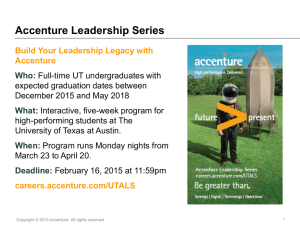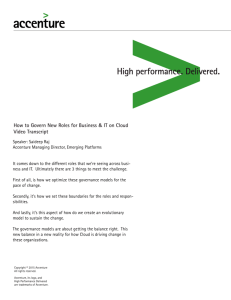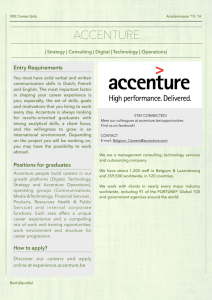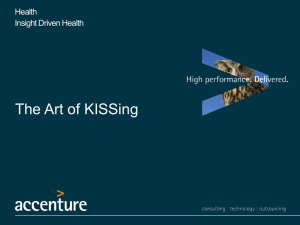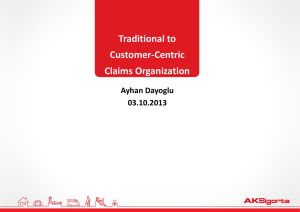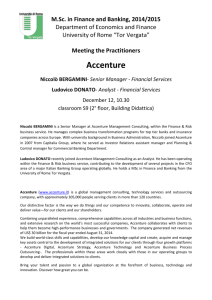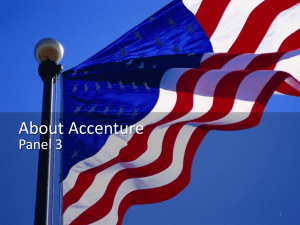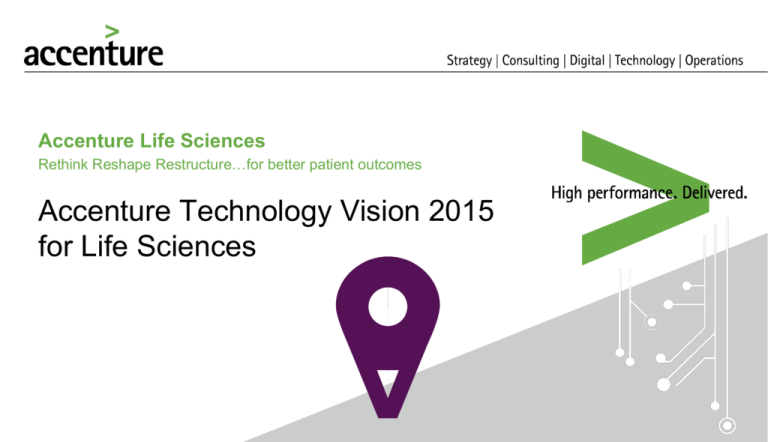
Accenture Life Sciences
Rethink Reshape Restructure…for better patient outcomes
Accenture Technology Vision 2015
for Life Sciences
Current as of 2/2015
2015 Technology Vision: Succeeding in the “We Economy”
Companies are connected to a digital fabric and a global network that
has the potential to touch all aspects of their business. This grand
network of businesses, individuals and things has the power to
introduce a new era in the digital age—the age of “digital ecosystems”.
The Accenture Technology Vision 2015 surveyed the opinions of
1000+ C-suite and D-suite executives across industries from around
the world about the technology trends. 100+ senior executives from
life sciences firms participated in the survey across key developed
and developing markets. Key digital trends and their likely impact were
assessed in the survey.
Copyright © 2015 Accenture All Rights Reserved.
2
2015 Technology Vision: Succeeding in the “We Economy”
Life sciences companies get connected
9 out of 10 life sciences respondents believe that “industry
boundaries will dramatically blur as platforms reshape
industries into interconnected ecosystems”
70% of respondents believe that
60% plan to engage with
45% of respondents in developed
the next generation of platforms will
not be led by tech companies, but by
industry players and leaders
new digital partners in the
industry in the next 2 years
markets are already using industry
platforms to integrate data with digital
business partners, while 26% are
experimenting with such platforms
Copyright © 2015 Accenture All Rights Reserved.
3
2015 Technology Vision: Succeeding in the “We Economy”
The Life Sciences Industry
Boehringer Ingelheim, WellPoint
and HealthCore Announce First
Project Under Multi-Year
Research Collaboration
Novartis, Qualcomm to launch
$100M “beyond the pill”
investment fund
Jan 2015 MobiHealthNews
Nov 2014 Yahoo Finance
Sanofi aims for outcomes
with brand-new Chief
Patient Officer
23andMe and Genentech
in deal to research
Parkinson’s treatments
Mar 2014 FiercePharma
Jan 2015 SFGate
Jun 2014 FiercePharma
The Liquid Biopsy
Will Boost Revenue
For Sequenom
And Illumina
Jan 2015 Seeking Alpha
Genentech, PatientsLikeMe team
to explore real-world experience
GlaxoSmithKline is testing mobile
health sensors for clinical trials
Apr 2014 PharmaTimes
Nov 2014 MobiHealthNews
Copyright © 2015 Accenture All Rights Reserved.
AstraZeneca to
develop mHealth
cardiovascular services
Novartis, Merck
KGaA use digital
tracking in MS
patients to up their
competitive game
Jun 2014
FiercePharma
4
Life Science Industry Landscape Macro Trends
Economic
Reality
HC > GDP
Reform Austerity
Patent
Cliff
Outcomes-Based
Reimbursement
Market
Changes
Silver
Tsunami
7Bn/Emerging
Markets
Chronic Diseases &
Health/Wellness
Product
Changes
Scientific
Break-throughs
Rise of
Generics Globally
Rise of
Specialized
Medicine
Digital
Disruption
Collaboration
Platforms
Consumerization
of Healthcare
Data-Driven
Enterprise
Business
Model
Disruption
The “Outside In”
Enterprise
Convergence
The Pivot to
the Patient
Source: Accenture Research Jan-15.
Copyright © 2015 Accenture All Rights Reserved. Source: Accenture Research based on Capital IQ Nov 2014
Accenture estimates
that digital disruption
has the potential to
unlock more than $100
billion of commercial
value in the US alone,
over a five-year period
through new digital
business models. Who
will capture the lion’s
share of the market and
money. Will it be
traditional players in life
sciences? Players from
other segments of the
healthcare industry?
Companies from
consumer products,
high tech, or
communications? Or
will entirely new
companies emerge to
seize the prize?
Hot trend
5
Five trends prove that digital is
dramatically influencing the industry
today, and well into tomorrow.
Copyright © 2015 Accenture All Rights Reserved.
6
1. The Internet of Me:
Healthcare personalized
Welcome to the era of highly personalized care, monitoring and
treatment, building trust through meaningful patient experiences.
Copyright © 2015 Accenture All Rights Reserved.
7
1. The Internet of Me: Healthcare personalized
Forward thinking businesses are capturing mindshare by creating highly personalized,
delightful digital experiences that engage and exhilarate consumers, while maintaining their trust.
HOW IS THE LIFE SCIENCES INDUSTRY IMPACTED?
1. Engage in the wellness revolution
2. Personalize the patient journey
There is a huge opportunity to digitally
engage in disease prevention, monitoring
and treatment. Apps and wearables are being
used to promote general wellness and
treatment delay or prevention.
The nature of access points is changing
as the focus is shifting to patient
journeys and creating delightful digital
experiences. Channels are evolving from
the Internet to mobile to the Internet of
things, which is now getting personal,
benefiting the patient.
Copyright © 2015 Accenture All Rights Reserved.
3. Establish and maintain
trusted, digital havens
To succeed in creating highly
personalized experiences life
sciences companies must create
a bond of trust between them and
the patient, for service adoption
to flourish.
8
1. The Internet of Me: Healthcare personalized
>$4.6B
incremental revenue
in 5 years
In the US branded pharmaceutical market, customer experience could
drive $4.6B in incremental revenue, according to Accenture Analysis.¹
EXAMPLES
WellDoc’s BlueStar®, recently approved by the FDA, this platform is
the first mobile prescription therapy for type 2 diabetes. It provides realtime motivational, behavioral and educational coaching to help
patients self-manage their diabetes treatment plan and is
reimbursable by insurers.
PhysIQ, a device-agnostic analytics platform is being used by healthcare
professionals to leverage new types of data being generated by IoT devices
such as fitness trackers. It can pull data from any combination of devices,
aggregate it, and deliver a single, comprehensive health score which is
intimately personalized: data is constantly generated by whichever devices
the user chooses, and the platform learns individual habits and tendencies
over time.
• Ownership of consumer wearables is expected to double year on year by 2016
• 73% of the life sciences IT and business executives we surveyed report either using or experimenting with wearables
and smart objects to engage customers, employees or partners
• 75% of survey respondents place the personalized customer experience in their top three priorities – 25% report it as their top priority
Copyright © 2015 Accenture All Rights Reserved.
9
2. Outcome Economy:
Hardware producing health results
New intelligence in embedded hardware and sensors is
giving patients and healthcare providers what they really
want: better health outcomes.
Copyright © 2015 Accenture All Rights Reserved.
10
2. The Outcome Economy: Hardware producing hard data
Intelligent hardware is bridging the last mile between digital enterprises and the physical world. The IOT is creating
opportunities to understand what customers are really trying to achieve and providing feedback on value, moving
from selling things to results.
HOW IS THE LIFE SCIENCES INDUSTRY IMPACTED?
1.
Drive patient outcomes
Smart, thoughtful patient
services are now possible
using accessible, competent
hardware. With sensitive,
significantly less expensive
sensors and highly connected
hardware, it will become
easier to personalize care,
measure value and target
desired outcomes.
Copyright © 2015 Accenture All Rights Reserved.
2. Adapt to a risk-adjusted
pricing world
Cloud based real-world big
data along with real-time
patient monitoring will help
drive value analytics,
providing insights into patient
outcomes that will ultimately
drive successful value based
pricing arrangements.
3. Re-invent R&D
Digital hardware is now
sufficiently evolved to
enable a re-invention of life
sciences R&D. Using
diagnostic apps, smart pills,
remote patient wearables,
almost every aspect of the
R&D process is ripe for
focusing on outcomes.
4. Own the platforms of the
upcoming sharing economy
Care coordination through
collaboration and data
exchange is receiving
increased emphasis, providing
opportunities for life sciences
companies to participate in the
outcome economy.
11
2. The Outcome Economy: Hardware producing hard data
$1.4B
If converting activities into currency promotes an increase in medication adherence of
even just 20 percent, total healthcare spending could be reduced by $1,074 annually
for every person with diabetes. The total savings would be $1.4 billion in the US.²
EXAMPLES
Proteus Digital Health is focused on improving
patient outcomes by integrating a tiny, inert sensor
in the pills it produces. The sensor acts in concert
with a wearable device and mobile app to provide
full “adherence transparency” for patients,
healthcare providers and payers. The Proteus
hardware-based system determines when
patients take their medications and also can
send alerts and reminders to the individual if
they forget to take a pill.
A pressure sensor has been used in the
development of a smart contact lens
called Triggerfish, which can measure,
monitor, and control intra-ocular
pressure levels for patients as well as
catch early cases of glaucoma. It
monitors this pressure for 24 hours and
then provides a record to the attending
physician.
A leading pharma company* wanted to understand
which diabetes patients were not achieving the best
clinical and emotional outcomes, so that it could
proactively work with doctors and patients to better
manage the disease. The company used predictive
intelligence and analytics expertise to see
exactly why and where patients fall short of
successfully managing the disease, helping it to
strongly advocate for specific treatment standards.
• 85% life science respondents believe that more intelligent hardware, sensors, and devices on the edge of networks
will lead to the industry shifting from selling products to selling outcomes
• 86% of life sciences respondents believe that embedded intelligence will deliver better outcomes for customers
Copyright © 2015 Accenture All Rights Reserved.
12
3. The Platform (R)evolution:
Defining ecosystems, redefining
Life Science
Healthcare IT platforms capture data from disparate sources
(e.g., wearables, phones, glucometers), and connect them bringing a
new era of personalized treatment through innovative patient services.
Copyright © 2015 Accenture All Rights Reserved.
13
3. Platform Revolution:
Defining ecosystems, redefining Life Science
Digital Industry Platforms and ecosystems are fuelling the next wave of breakthrough innovation and disruptive growth.
Large companies are finding new ways of connecting – letting others innovate for them, creating value for the enterprise
through collaboration and innovation.
HOW IS THE LIFE SCIENCES INDUSTRY IMPACTED?
Platform businesses are changing the world. According to Massachusetts Institute of Technology, “In 2013, 14 of the top 30 global brands by
market capitalization were platform oriented companies—companies that created and now dominate arenas in which buyers, sellers, and a
variety of third parties are connected in real time.”3 For life sciences we see potential for disruptors to emerge in four key ecosystems:
Provider – allowing two-way
external and internal
collaboration that enables
control of decision access points
and supports current functions
within clinical operations and
commercial operations.
Copyright © 2015 Accenture All Rights Reserved.
Patient – designed to support
patients end to end including
trial recruitment, pre-market
awareness, intelligent patient
services and smart population
management designed to
drive outcomes.
Product – optimized to bring
about the right stakeholders to
solve for right pills, services,
diagnostic apps that can be
effectively monetized.
Regulatory and reimbursement –
should generate high-quality
compliant content for approvals,
pricing and risk management ,
supporting current functions such
as reg. affairs., HEOR, Med affairs,
academic partnerships etc.
14
2. The Outcome Economy:
Hardware producing hard data
$19.2B
For each type 2 diabetes patient, at least $697 per year could be saved by using
digitally accessed intermediaries and remote monitoring for diagnosis and treatment—
resulting in total annual savings of $19.2 billion.4
EXAMPLE
Accenture Intelligent Patient Platform is an end to end platform supporting the end to end patient journey. It is built on the Salesforce
platform, to enable the design of more precise patient programs based on unique patient segment requirements. It is currently being
implemented or piloted by several major global life science companies. Eisai, Merck, Pfizer and others have joined together to build a
standards-driven platform to help pharmaceutical companies simplify and speed drug development. Accenture Life Sciences Cloud for R&D
brings together multiple internal and external data sources across non-competitive areas in clinical, safety, regulatory and operational
functions into a single analytics platform, creating actionable insights to accelerate drug development and improve patient outcomes.
• 80% of the LS survey respondents are strengthening digital capabilities by taking part in open innovation, using APIs to exchange data
and technology to delivery better outcomes to partners and customers
• 31% are using Industry platforms to integrate data with digital business partners and 41% are experimenting
Copyright © 2015 Accenture All Rights Reserved.
15
4. Intelligent Enterprise: Huge data,
smarter systems, better healthcare solutions
A data explosion, accompanied by advances in processing power, health analytics and
cognitive technology, is fueling software intelligence. Medical devices and wearables can
now recognize, “think” and respond to make rapid better informed decisions.
Copyright © 2015 Accenture All Rights Reserved.
16
4. Intelligent Enterprise:
Huge data, smarter systems, better healthcare solutions
With an influx of big data and advances in processing power, data science and cognitive technology, software intelligence
is helping machines make better informed decisions. Software intelligence will drive new levels of evolution and discovery.
HOW IS THE LIFE SCIENCES INDUSTRY IMPACTED?
1. Establish the data supply chain
• Commercial - provide payers the real world evidence for
value of drugs.
• R&D - improving predictive models – to evaluate patient
risks based on a wider set of sources and to target specific
patient populations.
• Medical – improved patient safety through rapid signal
detection of adverse events, including wider sources of data,
including social media.
Copyright © 2015 Accenture All Rights Reserved.
2. Invest in software intelligence to improve
big-data analytical capabilities
• To incorporate growing volume and variety of data ranging from lab
and imaging, remote monitoring sensor data to social posts etc.
• Early insight - The FDA’s recently announced it is collaborating with
online patient network PatientsLikeMe to determine how patientreported data can give new insights into drug safety.
• Intelligent decision making - Isabel Healthcare, offers a web-based
system designed to assist clinicians in diagnosing rare diseases.
The dynamic diagnosis checklist is provided as a standalone tool or
fully integrated with electronic records.
17
4. Intelligent Enterprise:
Huge data, smarter systems, better healthcare solutions
$1.9B
In value annually
Using treatment algorithms and automation to replace routine diabetesrelated decisions could help to prevent misdiagnoses lead to higher
costs and could save $1.9 billion annually.5
EXAMPLE
Bryn Roberts, global head of R&D operations at Roche in Switzerland, says, “A century’s worth of Roche R&D data were more than
doubled in 2011-2012 in a single large-scale experiment to sequence hundreds of cancer cell lines.” To derive more value from these
data sets Roche is collaborating with Point Cross to create a data platform that allows flexible searching of data from the past 25 years
of Roche studies, including those outsourced to CROs. Those data, along with information about thousands of compounds, will be
mined to develop new drugs.
Roche: http://www.sciencemag.org/site/products/lst_20140613.xhtml
• Over 40% of life sciences companies surveyed expect to see data volumes increase by at least 50% in the coming year
• Only 28% of businesses believe they are generating strategic value from the data they collect and 40% admit they need a plan to take
advantage of big data
• IDC predicts 44 Zettabytes of data by 2020. 10% will come from 32 Bn connected devices, more than twice the number today
Copyright © 2015 Accenture All Rights Reserved.
18
5. Workforce Reimagined:
Collaboration at the intersection
of humans and healthcare
As the digital revolution gains momentum, scientists and life science professionals are now
using machines to be more efficient, provide better decisions and take on increasingly more
complex tasks.
Copyright © 2015 Accenture All Rights Reserved.
19
5. Workforce Reimagined:
Collaboration at the intersection of humans and healthcare
The push to go digital is amplifying the need for humans and machines to do more, together. There will be a shift
from labor-driven technology-enabled paradigm to a digital-driven, human-enabled model advances in natural
interfaces, wearable devices, and smart machines will present new opportunities for companies to empower their
workers through technology.
HOW IS THE LIFE SCIENCES INDUSTRY IMPACTED?
1. Augment workforce productivity
2. Expand training
Augmented devices (e.g., smart glasses, wearables,
immersive technologies, and NLP) providing more
portability, insights, and unprecedented contextual
information to scientists, clinicians, and doctors during the
research, drug development and clinical trials process.
Life sciences companies will need to identify how to train
and certify both human and machine interfaces for R&D,
manufacturing, and sales divisions.
Copyright © 2015 Accenture All Rights Reserved.
20
5. Workforce Reimagined:
Collaboration at the intersection of humans and healthcare
30%
reduction in total cost
of ownership in 2018
Gartner predicts that by 2018, the total cost of ownership for business operations
will be 30 percent lower than today because of the wider use of smart machines and
industrialized services.6
EXAMPLES
Accenture and Philips demonstrated
how a doctor wearing Google
Glass in an operating room could
use the display to monitor a
patient’s vital signs while
performing surgical procedures, all
without turning away from the
patient molecules.
Copyright © 2015 Accenture All Rights Reserved.
Surgeons at Indiana University Health
Methodist Hospital have used Google
Glass assistance during the removal
of abdominal tumors. Augmented
devices were able to provide doctors
additional degrees of freedom, portability,
and insights about the patients.
Baxter’s Home choice Pro is a
peritoneal dialysis (APD)
system that allows the doctor to
remotely monitor the therapy.
The information captured by the
doctor can help decide if changes
to the treatment or prescriptions
are required.
Boehringer Ingelheim
partnered with Kaggle, the
gamification platform provider,
to leverage skills of data
scientists to create a new
model that will accurately
predict the biological response
of molecules.
21
5. Workforce Reimagined:
Collaboration at the intersection of humans and healthcare
74%
of all life sciences respondents believe
that companies will need to focus on
training their machines as much as
they do on training their people (e.g.,
using intelligent software, algorithms
and machine learning)
Copyright © 2015 Accenture All Rights Reserved.
Natural language processing to
grow to a $10B market by 2018
growing at 20% each year over
the next few years7
22
To capture the bigger prize, life sciences companies must
embrace digital holistically to improve patients' quality of life and
capture the more than $100 billion of commercial value in the US
over the next 5 years.8
Life Sciences companies from within and outside the traditional life sciences industry must embrace digital to
design and build entirely new business models that are dramatically changing the healthcare industry. They need to
go beyond the confines of traditional industry, product and customer boundaries to find entirely new ways to meet
address customer needs.
Copyright © 2015 Accenture All Rights Reserved.
23
References
1
Capturing the $100 billion opportunity for Life Sciences: are you a digital transformer or follower? Accenture 2015.
2
Sokol MC, McGuigan KA, Verbrugge RR, Epstein RS. Impact of medication adherence on hospitalization risk and healthcare cost.
“The Ups and Downs of Dynamic Pricing,” Innovation@Work blog, October 31, 2014. http://executive.mit.edu/blog/the-ups-and-downsofdynamic-pricing#.VG4yA_nF-bU.
3
4 Capturing
5
the $100 billion opportunity for Life Sciences: are you a digital transformer or follower? Accenture 2015.
Capturing the $100 billion opportunity for Life Sciences: are you a digital transformer or follower? Accenture 2015.
“Gartner Reveals Top Predictions for IT Organizations and Users for 2015 and Beyond,” Gartner, October 7, 2014.
http://www.gartner.com/newsroom/id/2866617.
6
“Natural Language Processing (NLP) Market worth $9,858.4 Million by 2018,” Markets and Markets, October 2013.
http://www.marketsandmarkets.com/PressReleases/natural-language-processing-nlp.asp.
7
8
Capturing the $100 billion opportunity for Life Sciences: are you a digital transformer or follower? Accenture 2015.
Copyright © 2015 Accenture All Rights Reserved.
24

